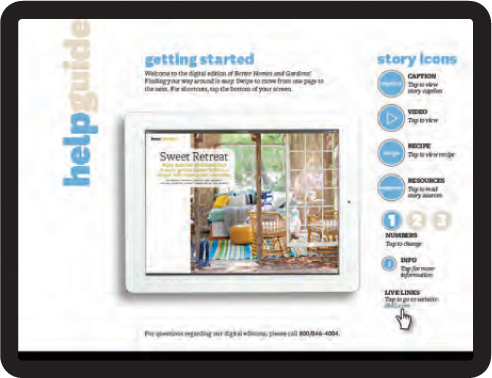1. Introduction
The last time technology was so disruptive to the field of graphic design and publishing was back in the 1980s, when page layout programs were part of a revolution called desktop publishing. Designers and publishers could use programs such as PageMaker or QuarkXPress to set type right at their desks — hence the term desktop publishing.
Designers had to learn new skills — not just to design pages and art, but to make documents flow correctly and import images with the correct color space and resolution. They had to deal with digital typefaces and missing fonts. (Fonts were always missing!)
But for the longest time, those programs stayed basically the same. Their final output was geared to print publishing. New features were added, but they were always for the printed page.
Slowly, though, the publishing landscape began to change. File formats from Photoshop included the GIF and JPEG images used for web pages. A new page layout program called InDesign leveraged Adobe’s PDF format to create PDF documents that could be posted and read on the web. Slowly, print designers were exposed to new concepts in computer graphics, mostly related to the web and onscreen PDFs. Designers had to learn a new set of skills for digital and interactive document production.
But all that change was tame compared to what has happened in the past three to four years. The number of print books sold has been surpassed by the number of books downloaded from sites such as Amazon and iTunes. Print magazines have been brought back to life as interactive applications. Corporations are creating presentations for computer screens instead of printed brochures.
It’s a whole new world of digital publishing. Exciting times, yes, but the print designer has to rethink and relearn a whole new world.
Who Are We?
We both have backgrounds in traditional publishing, including advertising and design. But individually we have worked with clients to help them create interactive PDF presentations, ePubs, and tablet applications. We’ve added movies and interactive elements to educational materials that were originally created for print output, and posted them online. Both of us have taught hundreds of hours of classes on the new digital output formats. We’ve written articles and books on how to create interactive PDF documents. And the two of us have seen our own print books sold as ePubs on Amazon and iTunes.
It hasn’t been easy
That’s not to say we haven’t struggled. Both of us had to learn how to format media files so they work on multiple output devices. We had to learn how to read basic HTML and CSS code and learn the proper formats in which to hand over our projects to web designers and Flash ActionScript developers. Both of us had to learn how to apply and modify animation controls. And most of all, we had to learn how to think differently about the presentation of information that’s in a digital format, free from the printed page.
So we feel much empathy with you. That’s why we wrote this book. This is the book that we wish we’d had years ago to take us through the intricacies of digital publishing.
Who Are You?
You are the students we’ve taught for the past few years who are struggling to keep up with the new technologies. You might be a designer who suddenly realizes that you need to master the features of complicated and strange workflows. You could be a department head who is looking to expand from print into digital production and needs to know the right format for each job. You’re a freelancer who needs to improve your skills to keep up with the latest trends.
Most likely you’re confused and overwhelmed. This book was written with you in mind.
Don’t feel alone. This sea change affects every designer, publisher, and creative professional in every field. The following sections outline the impact on those in many different roles.
Advertising designers
Advertising has been at the forefront of creating ads and marketing information for digital publications. For instance, interactive 360° images can be used to show a car interior, and panoramas can show the beautiful vistas seen from the newest resort hotel. Videos can show any product in a way that print never could.
Today’s advertising art directors and creative directors need to understand the possibilities for converting the layouts for print ads and brochures into digital publications. They need to know how to convert television commercials into videos that can be incorporated into digital delivery. They will want to change an ad’s orientation from horizontal to vertical — while perhaps changing its content as well.
This ad for MasterCard takes advantage of the dual orientation for tablets. It shows certain information in the vertical orientation (left) and different information in the horizontal view (right).
Book designers
It’s hard to find a major (or minor) publishing house that is not creating ePubs. Their challenge is to maintain design standards within the limited layout controls of the ePub formats but at the same time understand what enhancements can be made to eBooks. And they need to evaluate what new workflow and staff are necessary to manage both print and digital publishing.

The broad distribution of ePubs has added new life to old books.
Magazine designers
Many major magazine publishers have enthusiastically embraced converting their magazines into digital publications. Their designers have been leaders in using InDesign’s Digital Publishing Suite (DPS) for designing interactive apps to achieve exciting results.
Wired was the very first magazine to use InDesign and DPS tools to create an app for the iPad. With help from Adobe, that first issue became a landmark publication, with almost every interactive technique featured in the magazine. Since then, Wired has continued to make their digital publication as cutting-edge as possible.
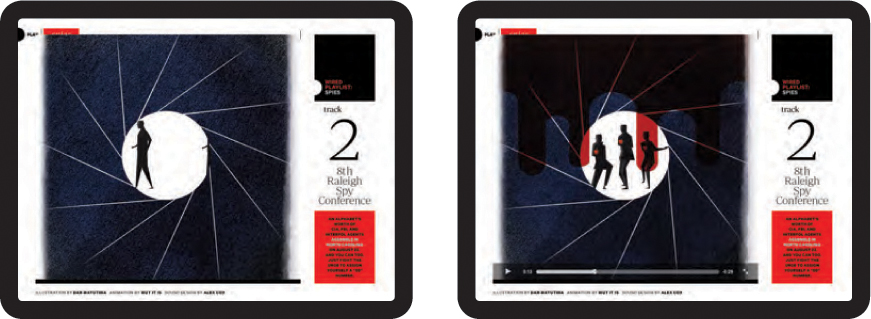
Wired magazine has used videos in its digital version. In this example, an article on spies features a video of the opening of the James Bond movies.
Magazines have even created content for their digital versions that doesn’t appear in the print version. For instance, People magazine’s digital version has a final page feature that shows different covers from the past 35 years.
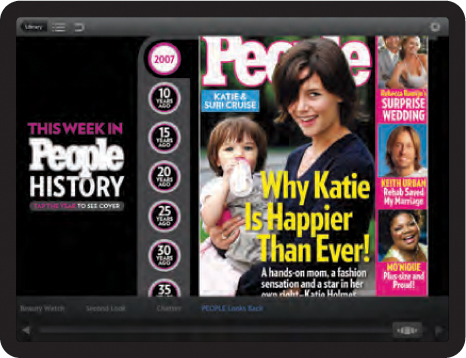
An example of the special feature on cover images that appears in the digital — but not the print — edition of People magazine.
In addition, magazine publishers have created new subscription options. Many print subscriptions now also include access to the digital version. Condé Nast, Hearst, Meredith, News Corp., and Time Inc. have created a new subscription model called Next Issue. Sometimes referred to as “Netflix for magazines,” it allows, for a monthly fee, unlimited access to the publishers’ entire catalog of magazines.
In-house marketing designers
We’ve worked with many marketing departments who long ago embraced digital publications. Even if it was just a simple PDF of a print brochure, they were already using digital delivery for their sales message. They also were pleased with the relatively small cost of digital distribution compared to that of print runs with shipping and mailing costs.
Then they discovered how the features of interactive displays, video, and form fields could further enhance their PDFs. Today these designers are looking to interactive PDF as well as adding new digital formats to their marketing programs.
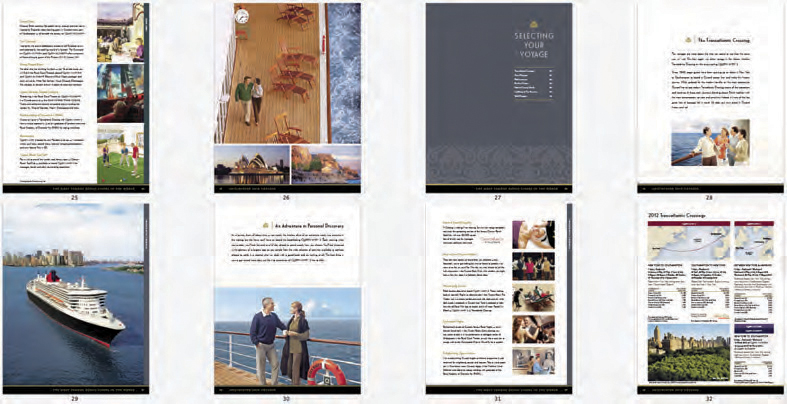
Instead of having a printed brochure mailed to them, Cunard customers can instantly download a PDF brochure.
Clients
Many clients are asking their design firms or ad agencies to “put something on the iPad.” That sort of vague direction doesn’t target the right audience for their product. In fact, there are many different types of files that can be delivered via tablet devices, including those we discuss in this book: interactive PDF, ePub, tablet app, and HTML. So a vague direction is no good at all.
The best clients are those who understand the possibilities (and limitations) of digital publications. They understand which format does what. And they understand that a certain format may be better for their needs. More than ever, today’s designers need to educate their clients about what options make sense for them.
The ePub format is suitable for an instructional guide such as Understanding the Golf Swing (left). But a catalog or magazine, like Martha Stewart Living (right), is more effective as a tablet app, where the user can tap each item for more information.
What you need to know before you use this book
While you may be a beginner in digital publishing, you shouldn’t be a beginner when it comes to creating InDesign documents. We’re assuming you have a pretty good knowledge of how to import graphics, format text, and use paragraph styles, object styles, and layers. If you need basic training, we recommend the InDesign CS6 Visual QuickStart Guide by Sandee Cohen.
However, we don’t expect you to have extensive knowledge of interactive features such as buttons, form fields, hyperlinks, electronic tables of contents, and media. We’ll take you through those features completely.
Digital Publishing Formats
There are many different formats for digital output from InDesign. The following are the digital formats you’re most likely to use as you explore the possibilities of digital publishing.

InDesign Workflows
InDesign has been, and is, at the center of the print design and production workflow, bringing together text, illustrations, and photographs from other programs. For digital publications, it becomes even more central in the workflow. It assembles information and assets, and its powerful export features and integration with Adobe’s Digital Publishing Suite make it more essential than ever — the “hub” of your publishing workflow.
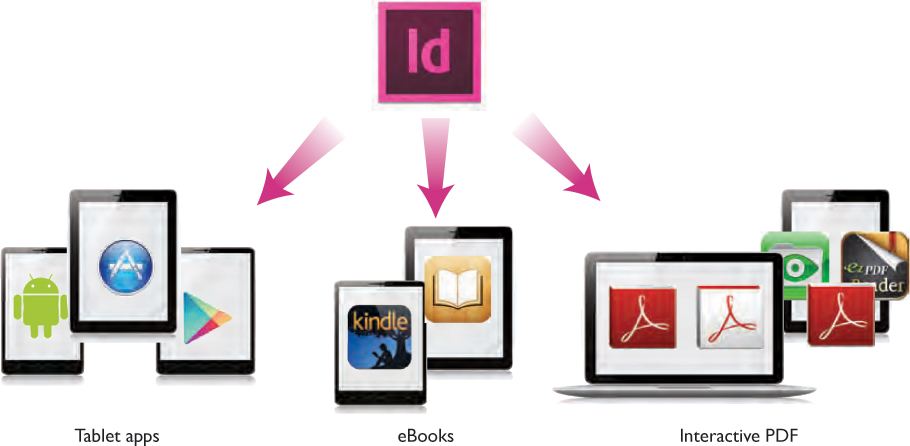
InDesign is one of the only tools that can create content for multiple digital formats.
InDesign as the “hub”
This book is very “InDesign-centric,” focusing on InDesign documents as the center of your workflow. Once you have created an InDesign file, it can be exported to a print PDF, an interactive PDF, an eBook, a tablet application, and so on. Corrections, updates, and changes are made to the original InDesign file and then re-exported to the various output formats.
Focus on InDesign features
We’ve had to narrow the scope of the book to cover InDesign’s features. For instance, InDesign lets you add interactive buttons and forms to documents for PDF export. While these features are exciting, they do not cover all the functionality found in Acrobat, Adobe’s PDF editing software. Rather than dipping into Acrobat, though, we’ve limited ourselves to just InDesign’s features for interactive PDFs.
Similarly, the workflow to create DPS apps and eBooks for the iPad relies on working with Apple to get approval for those products. We mention the process only briefly, as we can’t fully cover the requirements of third-party companies, especially those for creating applications.
And we don’t focus on some of the very important overall strategies. For example, building responsive websites using HTML5 may turn out to be one of the best and most flexible ways to produce digital content. But InDesign’s role in that strategy is quite limited, so we don’t cover building websites.
What is expected of a print designer?
It’s likely that when you started as a print designer, you had a basic understanding of the print process. You may have interacted directly with a printing company, making sure your files were set up to print correctly. But you never had to print the job yourself. And you usually were not responsible for the distribution of the printed piece, because that was up to your client or your client’s marketing department.
But with digital publishing, there are many different things you may need to know. When a client says, “I want my document on Kindle and iPad,” there’s a lot more involved in setting up your files correctly. You need to understand much more about how files are distributed and the limitations of each digital format. We’ll cover what jobs you need to know how to do and what you can safely ask others to finish.
For instance, many design firms have separate departments for print and web. You may not need to know Cascading Style Sheets (CSS) or Hypertext Markup Language (HTML), but you should know the proper ways to create the InDesign file that you’ll hand off to the next team.
This includes creating styles. Styles are essential; not only paragraph and character styles, but also object styles and table and cell styles have become essential in creating digital content. If you aren’t up to speed on using styles for print documents, few would know the difference (though you may spend extra hours producing the work), but you can’t live without them in the new digital world.
Thinking Digitally
There are other new skills that you need to use to work with digital publications. Most of all, you need to think differently.
Planning ahead
It does no good to be halfway through a project only to find out that the videos you were relying on won’t play in all formats, or that there’s no software to play your document on a certain type of tablet.
These chapters contain many tables that compare which features can be used in each type of digital publication. This can help you choose the right type of format. You’ll also find a few “war stories” that illustrate how a lack of planning can cause problems when the product is published.
Thinking non-linearly
As a print designer, you’re used to linear documents. Books start at the front page and work their way to the end. Ads start at the top of the page and read down. But digital publishing allows you to move off in many different directions.
Consider the story “Little Red Riding Hood.” While a book may flow from one page to another, a tablet app of the story can have tangents that send the reader to recipes for the goodies in the basket, an article on the wolves of North America, and the medical options for senior citizens.
Digital publications also provide opportunities for non-text features. For “Little Red Riding Hood,” this could include interactive maps for the route to Grandma’s house, videos of the latest movie about the story, or puzzles and games for children reading the story.
New ways of thinking about a page
In print documents, a page has no depth. Images don’t hide under each other. There are no layers to turn on to see things below. But in digital publications, a page can be as deep as you want. Images can be stacked one on top of another and be revealed by clicking buttons. The digital publishing designer should learn how to think in this new dimension.
The size of the objects on a page is flexible. Text can scroll into view within a small opening on the page. This makes it possible to present long recipes and other instructional text without taking up a lot of page real estate or reducing the type size. It’s a new way to present material on each page.
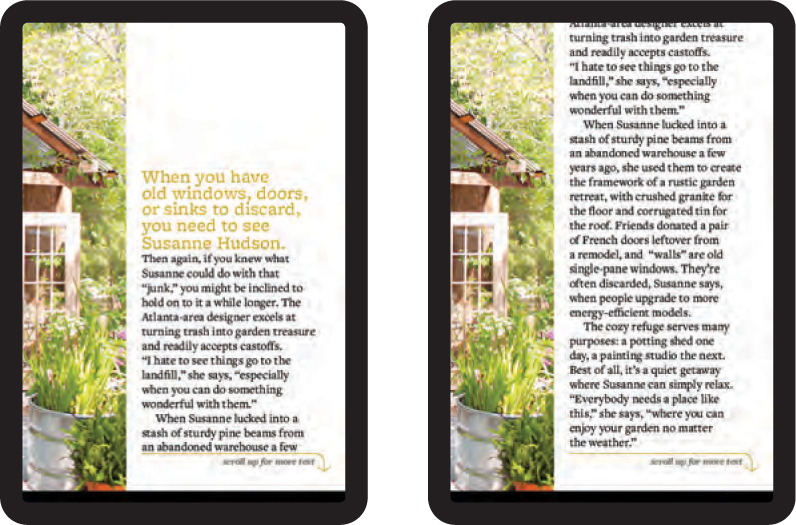
Better Homes and Gardens magazine uses a scrolling area to display more copy than would ordinarily fit on the page.
Adding multimedia to magazines and books
Creating digital publications also means that you can use video and audio files to enhance publications. This means you have to own or acquire the rights to use these files. Files also have to be in the proper format.
All of this requires a little extra work, but media files add tremendously to publications. We worked with an author who wrote an ePub guidebook based on his years of taking tourists around Rome. Instead of just describing a certain market or attraction, he inserted videos that show what to look for. The ePub guidebook is selling well—especially considering it was self-published, with little outside marketing.
Special features
Some features are automatically added to digital publications. Those who have read eBooks know that there is a built-in dictionary in iBooks and Kindle devices. Readers can look up the definition of any word they don’t know, and the definition is displayed right on the eBook page.
Readers can also highlight text, add notes, and search within text. This definitely enhances the process of reading. And the designer doesn’t have to do a thing to make it happen.

An eBook page in iBooks with a highlight, a note, and the definition of a selected word.
Engaging the reader
One important thing about advertising, especially direct mail, is that the longer someone engages with your material, the more likely they are to buy the product. Adding interactivity and multimedia to digital content, including advertising, helps keep the reader engaged. The longer someone plays with the buttons, watches movies, and works with elements on the page, the more positive feelings they will have toward the content or product.
Educating the reader
While it’s not necessary to show readers of print books how to turn a page, you do need to educate your audience on how to use the interactive and media features in your document. This may include an opening screen with instructions for the icons and features in your document. It may also include text and icons on the pages that alert the reader to an interactive feature.
A page of instructions appears at the top of the digital version of Better Homes and Gardens.
As readers become more familiar with the conventions used in digital publications, these types of instructions will become less necessary. Of course, as the next generation of readers comes of age, they will be far more comfortable using screens for digital publications. We’re reminded of a YouTube video that shows a 1-year-old expertly using an iPad — pinching and swiping — and then trying the same moves on a paper magazine without results.
Keeping Up With It All
Unlike print production technology, the digital publishing standards that are in effect when you start a project may change by the time you’re done, and the content you created and want to maintain and distribute may be rendered obsolete. Apple may change the process to upload apps or ePubs. Adobe may release new versions of the DPS tools. New PDF readers may become available for the iPad and other tablets. Amazon or Apple may change the features in their Kindle or iBooks publications.
You also may need to buy and maintain different hardware devices and software so you can test to make sure your digital publications run properly on each device. This includes computers running different operating systems; various versions of the iPad; and different versions of Android tablets, Amazon Kindles, and Barnes & Noble Nooks. In fact, you will most likely be designing for devices that haven’t been invented yet.
If it seems confusing, part of the reason is that digital publishing is in its very early stages and it’s a bit like the wild, wild West out there.
When we first started writing this book, we tried to make a diagram that clearly showed which InDesign interactive features could be output in each format. We soon ended up splitting the diagram into different devices, different manufacturers, and different reader apps to the point that it became more confusing than helpful. As of this writing, for example, video in an ePub doesn’t play on a branded Kindle reader, but it will play when viewed by Kindle reader software on a laptop or iPad. Or take buttons in PDFs: They work great when viewed on a computer, but when it comes to the iPad, different reader apps have different capabilities — buttons work in PDF Expert on the iPad but not in Adobe Reader on the iPad. And on it goes.
Digital publishing is as disruptive a technology to designers and publishers as desktop publishing was back in the 1980s. Standards are yet to be set; temporary players in the market have yet to be winnowed out. But still, you have to start somewhere. We hope that you’ll find this book an ideal starting point.
As for the wild West out there, you’ll find additional resources listed in several of the chapters. And because digital publishing is rapidly changing, we’re going to continue to help you keep current with new information on our blog.
Visit our blog at www.indesigndigitalpublishing.com. We’ll add information on new features and on new processes for creating digital publications as it becomes available. You can also email us at [email protected] with any questions or comments you may have. We’d love to hear from you.



